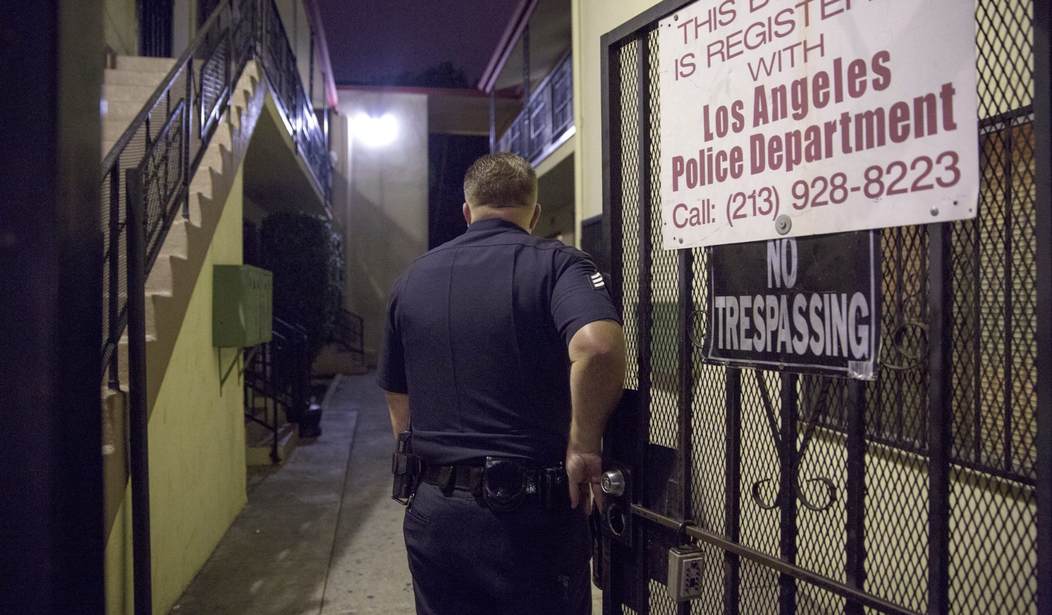Gentle readers, we return today to a topic that has become all too familiar: the Los Angeles Times and its eagerness to discredit law enforcement, most especially the Los Angeles Police Department.
On Thursday, the Times published a news story under the following provocative headline: “Stop-and-frisk in a car:’ Elite LAPD unit disproportionately stopped black drivers, data show.” Coming in at more than 2,500 words, the story decries the perceived racial disparity among the drivers stopped by a specialized unit of LAPD officers. Regular readers of the Times are accustomed to such stories, just as they are to the paper’s willingness to ignore relevant facts so as to advance the notion that minorities in Los Angeles are unduly put upon by the police.
In advancing this notion, Times writers Cindy Chang and Ben Poston resort to well-worn techniques, presenting what to the untrained reader seems to be a straightforward analysis of the data, then bolstering it with the opinions of purported “experts,” anecdotes from people who claim to have been victimized, and references to long-ago events.
The LAPD officers under scrutiny are assigned to Metropolitan Division, or Metro, an elite unit that includes SWAT and the mounted detail, but whose primary function is crime suppression. In an effort to stem a rise in violent crime, in 2015 the LAPD doubled the size of Metro, whose officers ride in unmarked cars and do not handle radio calls or perform other routine police duties. Their mission is to patrol those areas of the city most affected by crime and conduct vehicle and pedestrian stops on people who may be connected to it. And this is where they have aroused the suspicions of the Wise Ones at the Los Angeles Times.
“Nearly half the drivers stopped by Metro are black,” write Chang and Poston, “which has helped drive up the share of African Americans stopped by the LAPD overall from 21% to 28% since the Metro expansion, in a city that is 9% black, according to the analysis.”
In writing this, Chang, Poston, and their editors display a willful blindness to the reality of crime in Los Angeles, which is that criminals are not proportionally represented across all ethnic groups. This naiveté, displayed so consistently in the Times for so many years, can only be deliberate, for we are told in Mr. Poston’s bio that appends the story that he is a “data journalist,” whom we might presume to have competence in the analysis of data.
“More than 90% of the drivers stopped by Metro citywide since the expansion have been black or Latino,” we are told in the story, as if this disparity is significant. “Metro stops black drivers 13 times more often than white drivers.”
One would hope a man who identifies himself as a “data journalist” would investigate all the relevant data rather than imply police stops should conform to simple demographic patterns. One may hope, but that hope would end in disappointment.
Ms. Chang and Mr. Poston lament, “In much of Brentwood, Pacific Palisades, Silver Lake and Los Feliz, Metro officers have not stopped any drivers at all since the expansion.” Perhaps there’s an explanation for this that a “data journalist” might uncover. Perhaps the crime problems in Brentwood, Pacific Palisades, Silver Lake, and Los Feliz are somehow different from those in South Los Angeles.
It’s not as though the relevant data is hard to find. The LAPD crime statistics for 2016 are available online, and a quick glance at them reveals that West Los Angeles Division, which patrols Brentwood and Pacific Palisades, saw 538 violent crimes reported that year. Northeast Division, which includes Silver Lake and Los Feliz, saw 952. But in 77th Street Division, in South Los Angeles, police responded to 3,368 violent crimes in 2016, including 45 homicides, 1,238 robberies, and 1,938 aggravated assaults, a disparity that goes unaddressed in the Times story.
And there’s more. The LAPD’s 2017 Homicide Report, for example, looks at the 171 murder suspects identified in the city that year. Of these, 3 were Asian, 11 were white, 69 were black, and 84 were Hispanic. So, if we assume homicide statistics to be reflective of other violent crime in the city (and they are), we see that Hispanics offend at rates about equal to their share of the population, whites and Asians at rates less than their share, and blacks at rates greater than theirs. Yes, blacks make up just 9 percent of the population of Los Angeles, but in 2017, 40 percent of the city’s identified homicide suspects were black.
And yet, in the apparent opinion of the Los Angeles Times, police officers whose job it is to stem the tide of violent crime in the city should ignore these facts and indeed cocoon themselves in the same ignorance as that displayed on the pages of the Times when these issues are addressed.
But Ms. Chang and Mr. Poston do not merely rely on the dishonest use of statistics to advance the anti-police agenda. They also present the opinions of “experts” whose names regularly appear in stories of this nature and whose phone numbers surely are among the “favorites” on Times writers’ phones.
Civil rights attorney Connie Rice is one such “expert” on whom the Times can rely for a damning quote about the LAPD when the occasion demands. Another is Jay Wachtel, formerly an agent with the Bureau of Alcohol, Tobacco, Firearms and Explosives, and later a professor at Cal State Fullerton. Both of them reliably delivered what the writers were seeking. And no story of this nature would be complete without a quote from Peter Bibring, director of police practices for the ACLU of California, who, displaying an almost singular obtuseness, says, “How do [Metro officers] decide who is involved in more serious criminal activity? That kind of extreme disproportionality on the basis of race suggests that race is playing a factor, whether consciously or not.”
Also presented in the story are anecdotes from people who claim to have suffered under the oppression of the LAPD. One was particularly laughable. An unnamed 39-year-old “youth counselor” claimed to have been stopped three times in the previous month, twice by officers in unmarked SUVs of the type driven by Metro officers. But the story points out the man is, in fact, a gang member, that he admitted to speeding, and that his car had no license plates. Yet, Ms. Chang and Mr. Poston write, “He suspects he was targeted because of his race as well as his affiliation with the gang.”
One can but weep for the man.
And finally, Ms. Chang and Mr. Poston trot out a favorite old horse from the Times’s stable, references to LAPD scandals that were indeed genuine but which occurred so long ago as to be almost meaningless in today’s context. “Memories are still strong of the Dalton Avenue raid in 1988,” they write, “where phalanxes of police officers armed with sledgehammers and crowbars demolished a South L.A. apartment building, as well as the brutal beating of Rodney King and the riots that followed in 1992 after the officers were found not guilty.”
If you have to harken back to incidents of 26 and 30 years ago to make your claim of racial oppression, maybe things today aren’t really so bad after all.
But then, if things aren’t really all that bad, what need would there be for stories like this one in the Los Angeles Times? No, there wouldn’t.










Join the conversation as a VIP Member